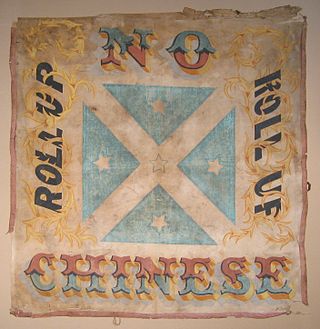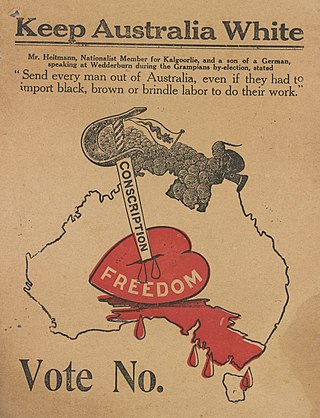Related Research Articles

The Eureka Rebellion was a series of events involving gold miners who revolted against the British administration of the colony of Victoria, Australia during the Victorian gold rush. It culminated in the Battle of the Eureka Stockade, which took place on 3 December 1854 at Ballarat between the rebels and the colonial forces of Australia. The fighting left at least 27 dead and many injured, most of the casualties being rebels. There was a preceding period beginning in 1851 of peaceful demonstrations and civil disobedience on the Victorian goldfields. The miners had various grievances, chiefly the cost of mining permits and the officious way the system was enforced.
This article describes the history of the Australian colony and state of Victoria.

The Burke and Wills expedition was organised by the Royal Society of Victoria in Australia in 1860–61. It initially consisted of 19 men led by Robert O'Hara Burke, with William John Wills being a deputy commander. Its objective was the crossing of Australia from Melbourne in the south to the Gulf of Carpentaria in the north, a distance of around 3,250 kilometres. At that time most of the inland of Australia had not been explored by non-Indigenous people and was largely unknown to the European settlers.

The Victorian gold rush was a period in the history of Victoria, Australia, approximately between 1851 and the late 1860s. It led to a period of extreme prosperity for the Australian colony, and an influx of population growth and financial capital for Melbourne, which was dubbed "Marvellous Melbourne" as a result of the procurement of wealth.

The Eureka Flag was flown at the Battle of the Eureka Stockade, which took place on 3 December 1854 at Ballarat in Victoria, Australia. It was the culmination of the 1851–1854 Eureka Rebellion on the Victorian goldfields. Gold miners protested the cost of mining permits, the officious way the colonial authorities enforced the system, and other grievances. An estimated crowd of over 10,000 demonstrators swore allegiance to the flag as a symbol of defiance at Bakery Hill on 29 November 1854. It was then flown over the Eureka Stockade during the battle that resulted in at least 27 deaths. Around 120 miners were arrested, and many others were badly wounded.

Peter Fintan Lalor was an Irish-Australian rebel and, later, politician who rose to fame for his leading role in the Eureka Rebellion, an event identified with the "birth of democracy" in Australia.


Bright is a town in northeastern Victoria, Australia, 319 metres above sea level at the southeastern end of the Ovens Valley. At the 2021 census, Bright had a population of 2,620. It is located in the Alpine Shire local government area.

Beechworth is a well-preserved historical town located in the north-east of Victoria, Australia, famous for its major growth during the gold rush days of the mid-1850s. At the 2021 census, Beechworth had a population of 3,290.

Robert O'Hara Burke was an Irish soldier and police officer who achieved fame as an Australian explorer. He was the leader of the ill-fated Burke and Wills expedition, which was the first expedition to cross Australia from south to north, finding a route across the continent from the settled areas of Victoria to the Gulf of Carpentaria. The expedition party was well equipped, but Burke was not experienced in bushcraft. A Commission of Inquiry held by the Government of Victoria to investigate the failure of the expedition was a censure of Burke's judgement.

Civil disturbances in Western Australia include race riots, prison riots, and religious conflicts – often Protestant versus Catholic groups.

Antoine Julien Nicolas Fauchery was a French adventurer, writer and photographer with republican sympathies. He participated in the national uprising in Poland in 1848, opened a photographic studio in Melbourne, Australia, in 1858, and was commissioned to accompany the French forces as they progressed to Beijing during the last stage of the Second Opium War in 1860. He wrote thirteen long dispatches from the front-line for le Moniteur, the official French government newspaper. He died in Yokohama of dysentery.

Porepunkah is a town in northeast Victoria, Australia on the Great Alpine Road, at the foot of Mount Buffalo 320 kilometres (199 mi) northeast of the state capital, Melbourne and 5 kilometres (3 mi) northwest of Bright. It is part of Alpine Shire local government area and on the banks of the Ovens River, near the Buckland River junction. At the 2016 census, Porepunkah had a population of 941.

Racism in Australia comprises negative attitudes and views on race or ethnicity which are related to each other, are held by various people and groups in Australia, and have been reflected in discriminatory laws, practices and actions at various times in the history of Australia against racial or ethnic groups.

The Buckland River, a perennial river of the North-East Murray catchment of the Murray-Darling basin, is located in the Alpine region of Victoria, Australia. It flows from the eastern slopes of the Buffalo Range in the Australian Alps, joining with the Ovens River at Porepunkah.

During the Australian gold rushes, starting in 1851, significant numbers of workers moved from elsewhere in Australia and overseas to where gold had been discovered. Gold had been found several times before, but the colonial government of New South Wales had suppressed the news out of the fear that it would reduce the workforce and destabilise the economy.
Joseph Andrew Rowe was an American equestrian and manager of circus companies. In 1849 he brought the first circus entertainment to West Coast of the United States, in San Francisco.

John Melton Black (1830–1919) was a pioneer of Townsville, Queensland, Australia. Black ordered the expedition of Cleveland Bay to find a suitable site for a port and then established the Port of Townsville and the associated town of Townsville. He served for two terms as Mayor of Townsville.

Lowe Kong Meng was a Chinese-Australian businessman. Born into a trading family in Penang, Kong Meng learned English and French at an early age and worked as an importing merchant around the Indian Ocean. In 1853 he moved to Melbourne where he started a business importing goods for Chinese miners during the Victorian gold rush. After 1860, as the Chinese population in Melbourne peaked, he diversified into other lines of business, including investing in the Commercial Bank of Australia. Kong Meng was a prominent and well-regarded member of Melbourne's elite, and for a time was one of the city's wealthiest men. He was a leading defender of Chinese Australians at a time when their status was politically controversial and they were subjected to targeted taxation, discrimination and violence.
The following bibliography includes notable sources concerning the Eureka Rebellion. This article is currently being expanded and revised.
References
- 1 2 3 4 5 Myra Willard (1967). History of the White Australia policy to 1920. Routledge. pp. 24–26. ISBN 978-0-7146-1036-8 . Retrieved 10 November 2010.
- ↑ Rosemary Van den Berg (2002). Nyoongar people of Australia: perspectives on racism and multiculturalism. Brill Academic Publishers. pp. 114–115. ISBN 978-90-04-12478-3 . Retrieved 10 November 2010.
- ↑ James Jupp (2002). The Australian People: An Encyclopedia of the Nation, its People and their Origins. Cambridge University Press. p. 202. ISBN 978-0-521-80789-0 . Retrieved 10 November 2010.
- ↑ Kevin Baker (2006). Mutiny, Terrorism, Riots and Murder: A History of Sedition in Australia and New Zealand. Rosenberg. pp. 150–151. ISBN 978-1-877058-49-3 . Retrieved 10 November 2010.
- ↑ "RIOT AT THE BUCKLAND". The Argus . Melbourne. 9 July 1857. p. 6. Retrieved 8 September 2011– via National Library of Australia.
- ↑ "CHINESE IMMIGRATION". The Argus . Melbourne. 15 January 1857. p. 4. Retrieved 8 September 2011– via National Library of Australia.
- ↑ Elizabeth Morrison (2005). Engines of influence: newspapers of country Victoria, 1840-1890. Melbourne University Press. p. 107. ISBN 978-0-522-85155-7 . Retrieved 10 November 2010.
- ↑ The Irish metropolitan magazine. Dublin: W. Robertson. 1858. p. 635. Retrieved 10 November 2010.
- ↑ George Fetherling (1997). The gold crusades: a social history of gold rushes, 1849-1929. University of Toronto Press, Scholarly Publishing Division. p. 60. ISBN 978-0-8020-8046-2 . Retrieved 10 November 2010.
- ↑ "TRIAL OF THE BUCKLAND RIOTERS". The Argus . Melbourne. 12 August 1857. p. 6. Retrieved 8 September 2011– via National Library of Australia.
- ↑ "POLICE". The Argus . Melbourne. 18 August 1857. p. 6. Retrieved 8 September 2011– via National Library of Australia.
- 1 2 "Buckland Riots". Monument Australia. Retrieved 18 December 2012.
- ↑ "Activities: Buckland memorial". Chinese Australian Family Historians of Victoria. 2007. Archived from the original on 18 February 2011. Retrieved 10 November 2010.